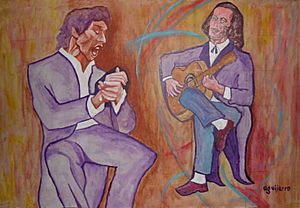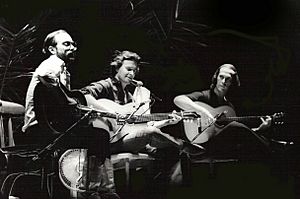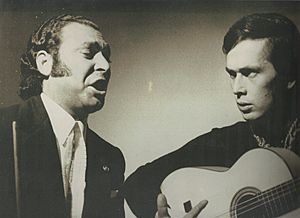Paco de Lucía facts for kids
Quick facts for kids
Paco de Lucía
|
|
|---|---|

De Lucía performing in 2007
|
|
| Background information | |
| Birth name | Francisco Sánchez Gómez |
| Born | 21 December 1947 Algeciras, Cádiz, Spain |
| Died | 25 February 2014 (aged 66) Playa del Carmen, Mexico |
| Genres | |
| Occupation(s) | |
| Instruments | Flamenco guitar |
| Years active | 1958–2014 |
| Associated acts |
|
| Awards |
|
Francisco Sánchez Gómez (born December 21, 1947 – died February 25, 2014), known as Paco de Lucía, was a famous Spanish flamenco guitarist, composer, and music producer. He was a master of the flamenco guitar and helped create a new style called new flamenco. Paco de Lucía was one of the first flamenco guitarists to also play classical music and jazz. Many experts, like Richard Chapman and Eric Clapton, called him a "titanic figure" in flamenco guitar. Dennis Koster even said he was "one of history's greatest guitarists."
Paco de Lucía was known for his incredibly fast and smooth finger movements, called picados. He was great at mixing fast finger runs with flamenco strumming, known as rasgueados. He also added new chords and jazz sounds to his music. These fresh ideas helped flamenco music grow and led to new styles like Latin jazz fusion starting in the 1970s. He became very famous for his recordings with flamenco singer Camarón de la Isla. They made ten albums together, which are considered very important in flamenco history.
Some of Paco de Lucía's most famous songs include "Río Ancho", "Entre dos aguas", and "La Barrosa". He became popular outside Spain in the late 1970s by working with guitarists like John McLaughlin, Al Di Meola, and Larry Coryell. In 1981, he formed the Paco de Lucía Sextet with his brothers. He also worked with jazz pianist Chick Corea on their 1990 album, Zyryab. After 2004, he performed less often, mostly giving concerts in Spain, Germany, and at European festivals.
Contents
Biography
Early Life and Musical Beginnings
Paco de Lucía was born on December 21, 1947, in Algeciras, a town in southern Spain. He was the youngest of five children. His father, Antonio Sánchez Pecino, was a flamenco guitarist. His mother, Lúcia Gomes, was Portuguese. His brothers, Pepe de Lucía and Ramón de Algeciras, also became famous flamenco musicians.
When Paco was young, there were many boys named Paco in Algeciras. To tell them apart, people would say "Paco, son of Lucía." This is how he got his stage name, Paco de Lucía, honoring his mother.
Paco's father taught him to play the guitar at a very young age. He was strict, making Paco practice up to 12 hours a day from age five. His father even took him out of school so he could focus only on guitar. Paco once said, "I learned the guitar like a child learns to speak."
Paco's brother Ramón looked up to a guitarist named Niño Ricardo. Ramón taught Paco Ricardo's complex guitar pieces, called falsetas. Paco learned them easily and often changed them to make them his own. Ricardo became Paco's first guitar hero. In 1958, at age 11, Paco performed for the first time on Radio Algeciras. A year later, he won a special prize at a flamenco competition.
Becoming a Star
At 14, Paco made his first record with his brother Pepe, called Los Chiquitos de Algeciras (The Little Ones from Algeciras). In the early 1960s, Paco toured with the flamenco dance group of José Greco. In New York City in 1963, he met two important guitarists, Sabicas and Mario Escudero. They became his mentors and friends, encouraging him to write his own music.
In 1964, he recorded three albums with guitarist Ricardo Modrego. These early albums were traditional flamenco. In 1967, he released his first solo album, La fabulosa guitarra de Paco de Lucía. He also performed at the 1967 Berlin Jazz Festival. This festival sparked his lifelong interest in jazz.

In the late 1960s, Paco toured Europe and met singer Camarón de la Isla. They worked together from 1968 to 1977, recording ten albums that are very important in flamenco history. Their partnership was key to flamenco in the late 20th century. Paco also recorded many albums with his brother Ramón.
Innovations and Global Recognition
In 1971, Paco released El mundo del flamenco. His 1972 album, El duende flamenco de Paco de Lucía, was seen as a major step forward in flamenco. As the 1970s went on, Paco continued to create new albums with jazz influences. His album Fuente y caudal became famous for the song "Entre dos aguas". This song, a rumba with bongos and electric bass, became one of his best-known pieces. Its title means "Between two waters," referring to his hometown of Algeciras, where the Mediterranean Sea meets the Atlantic Ocean.
The Fuente y caudal album was a bestseller in Spain. Paco and his producer, José Torregrosa, found that adding more instruments and moving away from strict traditional flamenco made their music more popular. Paco started to create his own unique style, blending jazz and other sounds, but always keeping his flamenco roots.
On February 18, 1975, Paco de Lucía made history by being the first flamenco artist to perform at the Teatro Real in Madrid. His performance was technically brilliant and showed his deep connection to traditional flamenco. This concert was released as the album En vivo desde el Teatro Real.
His 1976 album, Almoraima, was also very successful. It included the popular song "Río Ancho". The album had strong Arabic and jazz influences. Paco performed on the British TV show Parkinson, where he was introduced as a "marvelous young musician" who was becoming a big star in Europe.
In 1977, Paco married Casilda Varela, and they had three children. He released his last album with Camarón de la Isla, Castillo de Arena. After this, he focused more on instrumental music, saying that the human voice was "too limited" for his musical explorations.
Paco toured widely in the US and Europe, gaining popularity outside Spain. He became very interested in jazz fusion and rock music. In 1977, he performed with Carlos Santana in Barcelona. He was also invited by Al Di Meola to play on his song "Mediterranean Sundance" for the album Elegant Gypsy. This collaboration brought new attention to flamenco, even though some traditional flamenco critics didn't like it.
In 1979, Paco de Lucía, John McLaughlin, and Larry Coryell formed The Guitar Trio. They toured Europe and released a video called Meeting of the Spirits. Paco learned a lot from these jazz musicians, who had advanced musical knowledge and could improvise well. He said, "I have never lost the roots in my music, because I would lose myself. What I have tried to do is have a hand holding onto tradition and the other scratching, digging in other places, trying to find new things I can bring into flamenco."
The Guitar Trio and Later Works

The Guitar Trio continued to tour in 1980. In 1981, Al Di Meola replaced Larry Coryell. Paco found it challenging to improvise with McLaughlin and Coryell because he hadn't formally studied music. He admitted, "Some people assume that they were learning from me, but I can tell you it was me learning from them."
In 1981, The Guitar Trio released their very successful album, Friday Night in San Francisco. It sold over a million copies and made flamenco music much more popular in America and Europe. This album featured a long version of "Mediterranean Sundance" and "Río Ancho". Also in 1981, Paco formed the Paco de Lucía Sextet with his brothers Ramón and Pepe.
In 1982, Paco de Lucía performed with jazz pianist Chick Corea. Corea greatly influenced him in the 1980s. In 1983, The Guitar Trio released Passion, Grace & Fire. Paco also acted in the film Carmen and composed music for it, earning a nomination for a BAFTA Film Award. He also created music for the 1984 film The Hit with Eric Clapton.
By the mid-1980s, both the Sextet and the Guitar Trio stopped performing together regularly. Paco continued to perform with McLaughlin as a duo. In 1987, Paco performed in the Soviet Union for the first time. He also released his highly successful album, Siroco, which is often called one of the greatest flamenco albums ever. Songs like "La Cañada" and "La Barrosa" from this album became modern flamenco classics.
New Directions and Final Years
In 1990, the Sextet reunited to record Zyryab, an album that blended Arabic flamenco and jazz. It featured jazz pianist Chick Corea and flamenco guitarist Manolo Sanlúcar. The album was named after Ziryab, an ancient musician who brought the Persian lute (a type of guitar) to Spain.
Before 1991, Paco de Lucía couldn't read musical notation well. However, he learned to play Joaquín Rodrigo's famous Concierto de Aranjuez. His performance with the orchestra was highly praised, even by composer Rodrigo himself. In 1992, he performed at the Seville Expo '92, and in 1993, at the Plaza Mayor in Madrid. In 1995, he and Bryan Adams recorded the hit song "Have You Ever Really Loved A Woman" for the film Don Juan DeMarco.
In 1996, his "golden hits" album, Antología, was very popular in Spain. In 1998, he released Luzia, which he dedicated to his dying mother. This album is considered one of his most complete and artistic works.
Paco de Lucía lived in Mexico for five years but returned to Spain in 2003. He was tired of constant touring. He still kept a holiday home in Mexico and visited often. After 2004, he performed much less, usually only a few concerts a year in Spain, Germany, and at European festivals. He was a very private person and found the pressure of fame difficult.
In 2004, Paco de Lucía released Cositas Buenas. This album won the Latin Grammy Award for Best Flamenco Album in 2004. In 2004, he also won the Prince of Asturias Awards in Arts, a very important award in Spain. In 2007, the University of Cadiz gave him an honorary degree for his musical contributions. In 2010, he received another honorary doctorate from Berklee College of Music in Boston.
Death
Paco de Lucía died from a heart attack on February 25, 2014. He was on holiday with his family in Mexico. He was playing soccer with his son on the beach when he felt unwell. He was taken to the hospital but lost consciousness and passed away.
His brother Pepe said that Paco had recently quit smoking and planned to exercise more. Paco de Lucía is buried in the cemetery of his hometown, Algeciras. After his death, his album Canción Andaluza won the Latin Grammy Award for Album of the Year in 2014. The city of Madrid also named a new metro station after him as a tribute.
Legacy
Paco de Lucía is widely seen as the world's best flamenco guitarist and one of Spain's greatest musicians. He completely changed flamenco music as both a composer and a performer. His impact on flamenco guitar is often compared to Andrés Segovia's influence on classical guitar.
His album Fuente y Caudal is often said to have changed the world of flamenco guitar. Along with Enrique Morente and Camarón de la Isla, Paco de Lucía was one of the first artists to move beyond traditional flamenco and create nuevo flamenco (new flamenco). He was also the first Spanish artist to regularly mix jazz with traditional Andalusian music.
Paco de Lucía was fascinated by jazz and greatly respected jazz musicians. Despite these influences, many flamenco fans divide the music's history into "Before Paco" and "After Paco." He once said, "The more technique you have the easier it is to express yourself. If you lack technique you lose the freedom to create." He often played Hermanos Conde guitars and had his own special model.
Richard Chapman and Eric Clapton described Paco de Lucía as a "titanic figure" in flamenco guitar. They highlighted his amazing technique and creativity, and how he brought ideas from other styles like Brazilian music and jazz. He was known for his new harmonies and his incredible skill and strength with his right hand, allowing him to play very fast and smoothly. He was a master of contrast, often mixing fast picados with strumming rasgueados.
Bill Milkowski described him as focused and perfect, with a proud and majestic presence. Craig Harris noted his "deeply personal melodic statements and modern instrumentation." Atlanta magazine said that when he played, he could create "some of the most incredible music."
José Luis Acosta, president of the Spanish Artists and Editors Society, said that "Paco was and will be a universal artist, who took the guitar and flamenco sentiment to the heart of the whole world." In 2015, Billboard magazine named him one of The 30 Most Influential Latin Artists of All Time. That same year, he was added to the Latin Songwriters Hall of Fame. On December 21, 2016, Google honored his birthday with a Google Doodle.
Another important contribution from Paco de Lucía was adding the cajón to flamenco music. This Afro-Peruvian instrument was shown to him by Caitro Soto during a visit to Peru in the late 1970s. Paco saw it as a perfect way to add percussion to flamenco. Along with Rubem Dantas, he made the cajón an essential part of modern flamenco.
A statue dedicated to Paco de Lucía stands in his hometown of Algeciras, looking over the harbor.
Discography
Filmography
A documentary about his life, called Paco de Lucía: La búsqueda, was released after his death on October 24, 2014.
Images for kids
-
Sherry barrel signed by Paco
See also
 In Spanish: Paco de Lucía para niños
In Spanish: Paco de Lucía para niños






